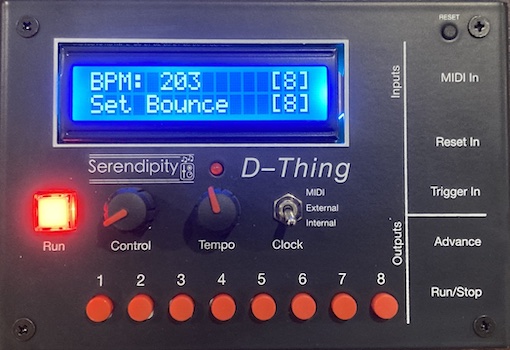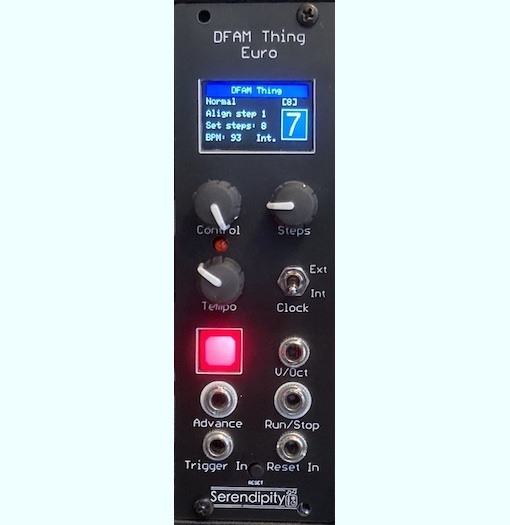

| Standalone | Eurorack |

|

|
The DFAM Thing is a device that adds significant capabilities to the DFAM sequencer, such as:
The new Eurorack version brings mostly the same capabilities in an 8HP Eurorack format, but with V/Oct CV support in place of MIDI.
The Primary DFAM Thing documentation can be found here.
The DFAM Thing Firmware Update guide can be found here.
The following video briefly shows the basic functions (using the internal clock).
(I will use the Arturia KeyStep as an example)
Select MIDI Mode using the Control encoder.
The MIDI Channel is shown in brackets (it can be any of channels 1 to 7, or * for all channels)
Ensure the Run button on the DFAM Thing is in its off state
Play notes either manually or by running a sequence on the KeyStep/MIDI Controller, and the DFAM Thing will convert them to steps ion the DFAM as follows:
If the Run button on the DFAM Thing is active, then triggering will occur not only when you play a note, but also when the clock fires. This can be quite effective, but is also a little confusing at first.
New in firmware 1.3 of the standalone DFAM Thing is support for MIDI CCs when in MIDI clock mode.
The DFAM Thing supports controlling the Run state of the DFAM via the Run/Stop output. But the DFAM behaves differently when controlled via its RUN/STOP input. Specifically, if you start it up with a run signal to the RUN/STOP input, the sequencer will start, but without triggers. You need to also send in a pulse to the TRIGGER input each step. However, if you start via the Run button on the DFAM, it will trigger with the Adv/Clock pulses.
To work around with the DFAM Thing, I mult the Advance output to both the Trigger input and the ADV/CLOCK input on the DFAM. But mostly I just don’t wire up the Run/Stop output and use the button in the DFAM instead.
In Firmware 1.1, an alternative use is available for the Run/Stop output, where it can be made to act as a cycle indicator instead, sending a pulse each time the sequencer pattern returns to its starting step. To toggle this option, keep the Control encoder pressed while the unit starts up. To know the current state, look for the ’*’ when the unit reports the firmware version — if present, the alternative mode is enabled.
The Eurorack version is an 8HP module, with V/Oct CV support in place of MIDI, and a dedicated encoder for selecting the number of steps in place of the 8 buttons of the standalone version.
To calibrate the V/Oct input, keep the Control encoder pressed on startup (for the original firmware version the Step encoder must be pressed as well) and hold down the asked for notes (C2 then C4). If the calibration fails, try adjusting the trimmer pot on the back of the lower board, and repeat.
In firmware v1.1, two additional options are available, and can be selected by holding down the Steps encoder on startup.
First is the alternative Run/Stop mode, discussed above in the context of the standalone version. Click the Control encoder for the default behaviour, and the Steps encoder for the alternative behaviour (as indicated by the positions of the “Run” and “Cycle” text).
Secondly, you can enable or disable the screensaver, that, if enabled, actives after 5 minutes of idle time.